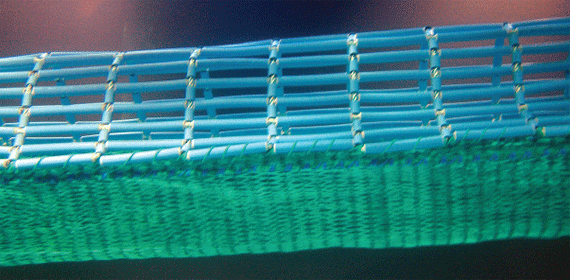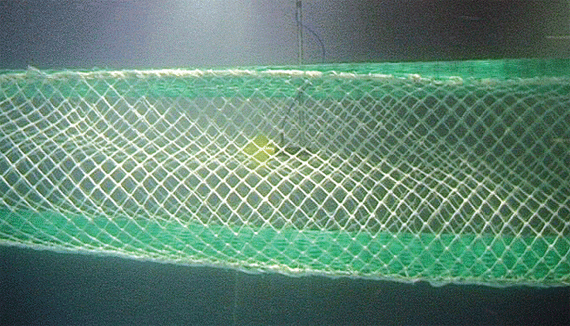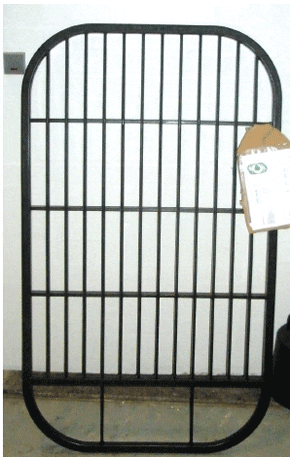
In the last in a series of
articles, Mike Montgomerie,
Gear Technologist at Seafish,
gives his perspective on the
issue and the work Seafish,
along with industry, has been
doing to help develop new
selective technologies and
net-based fishing activities to
reduce discards. In this article
he discusses the use of flexible
and rigid grids.
A variety of different flexible is limited due to the large
amount of fish being caught. If
the fish are scattered and the
net is in effect filtering the
water, the fish will probably
get easy access to the grid.
However, it is more usual
in pelagic trawling to target
shoals of fish, where a large
volume of fish will be passing
beneath the grid at one time
and only the ones at the top of
the net will get exposure to the
grid, thereby the opportunity
to escape.
Flexible grids with several
gap widths from 15mm to
25mm have also been trialled
in the Nephrops industry as
a size selection device for
Nephrops. These grids were
fitted in the lower panel of
the extension of the trawl, the
intention being to riddle out
the small Nephrops. It was
found that very few Nephrops
were released, even when a
grid with larger gaps was used.
This was probably due to the
shape and overall size of the
Nephrops as they tumble down
the trawl with legs and claws
sticking out, combined with
them not showing any escape
mechanism at this point in the
capture process. As would be
the case with many species,
they would need to be forced
out of the gaps by water flow,
or by some design feature in
the trawl. French fishermen
have been working on a grid
for selecting out the smaller
Nephrops. This grid is inclined
at 45 degrees and dropped into
the bottom panel of the trawl.
This allows all the Nephrops
exposure to it, releasing the
small ones and deflecting the
larger ones upwards and into
the codend.

Rigid Grids
Rigid grids are used in many
fisheries throughout the world
and have proved to be a very
efficient tool for the separation
of species in trawls. Because
they are a rigid structure it
is fairly easy for legislators
to regulate the grids overall
dimensions, bar spacing and
method of fitting. This helps
to ensure consistency in its
selectivity.
The rigid grid is fitted
in the trawl ahead of the
codend, inclined at an angle
of approximately 45 degrees,
with the bar spacing designed
to allow the target species to
pass through between the bars
and into the codend. The larger
bycatch is directed up and out
of the net through an escape
hole in the top panel of the
trawl.
Rigid grids are most
efficient when there is a big
difference between size of the
target species and the size of
the fish or shellfish that are to
be excluded from the trawl, as
in the turtle excluder device
and sea lion grids. Inclined
grids are also used in many
shrimp fisheries to separate
and release the fish while
retaining the shrimps.
Many rigid are made from
metal and can be cumbersome
to handle, particularly on
the smaller classes of vessels
which use net drums and
power blocks to handle the
gear. Some types of rigid grids
are made using several hinged sections which makes them
more manageable onboard,
but allows them to retain
their effectiveness in species
separation in the water.

A wide variety of grid
designs are already in use,
or are being trialled. These
include grids with different
bar spacings, vertical bars
and horizontal bars, and some
with a gap at the bottom to
allow the retention of bottom
fish and prevent the build up
of benthic debris. The size
and design of any grid needs
to be modified to suit the
specific fishery, taking into
account the vessels handling arrangements and the species
to be discarded. With careful
consideration of the fishery and
the grids design, 100% of the
larger fish have been shown to
be released.
Recently several
manufacturers have been
trialling grids made from semirigid
plastic materials. This
enables the grids to bend as
they are wound onto a net
drum, but return to their flat
form once the net is shot. This
will also make the grid much
easier and safer to use in the
tight confines on the stern of
a fishing vessel. Regardless of
what material the grid is made from it must be made to fit well
into the shape of the trawl, and
cover a large enough surface
area to allow good separation
of the relevant species.
Fitting rigid grids
The extension and last
tapered sections of an
average trawl will have a
cross sectional shape similar
to an oval or circle with a
circumference of approximately
2.1 metres when being towed.
To fit a rigid grid at 45 degrees
in this section the grid would
need to be in the region of
750mm long by 500mm wide.
Any bigger and the meshes will
be forced further open in the vicinity of the grid and liable
to allow the escape of target
species. This would also ruin
the streamlined shape of the
net.

To be its most effective a
rigid grid really needs to be
fitted further up the trawl,
where there is sufficient mesh
in the circumference to allow
the grid to be at sensible
proportions. A larger grid
gives the catch longer exposure
to the grid, and therefore
should improve its efficiency in
separating the catch.
If a square or rectangular
grid is fitted into a standard
two panel net there will be
distortion of the meshes
around the corners - it is like
fitting a square peg in a round
hole! This distortion will allow
target species to escape and,
in the longer term, will cause
stretching and abrasion of the
netting.
Ideally an oval-shaped grid
should be used in a two panel
net. For a rectangular grid,
it is better to fit a four panel
(or boxed) section into the
trawl to accommodate the
grid without distortion of the
meshes. A rectangular grid will
fit the cross-sectional shape
taken up by a four panel (or
boxed) section of netting. To
get maximum benefit from
a rectangular grid it may be
better to re-cut the aft end of
a two panel trawl into four
panels to fit the grid into.
Most grids are designed to
release by-catch that is larger
than the target species, but in
some fisheries a portion of the
by-catch may be of similar size
to the target species and will
pass through the grid. It may
be necessary to combine the
use of a grid with some other
discard reduction device to
allow the escape of the smaller
fish. This could be as simple
as larger mesh codends, or a
larger mesh size in the square
mesh panel. It is important to
assess that a grid is going to be
the most efficient and practical
discard reduction device before
using it in a specific fishery.
April 2012
Further Reading
|
| - | Go to our previous news item on this story by clicking here. |

